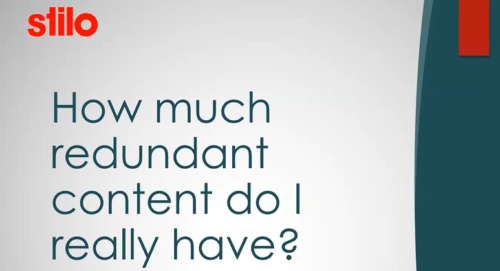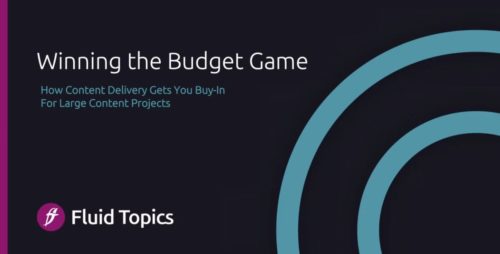-
April 6, 2022 Content reuse is one of the many advantages of moving to DITA and a structured standard. It helps us reduce the amount of overall content we have, improve consistency, and decrease redundancy. However, it is difficult to visualize this value before the conversion takes place. Estimates can be off, and it is hardly ever clear how much content we can actually reuse from our documentation. Typos and partial matches only complicate our futile estimates. Narrowing the scope of this approximation by investigating similar matches in our source content before conversion can provide valuable insight to the potential benefits of moving to a structured standard. Join TJ Dhaliwal in this session as he uses Stilo’s Analyzer and Migrate to investigate source content for similar and exact matches. Then, further use that information to plan for conrefs, keyrefs, and topicrefs before any transformation takes place. Conclude by deduplicating exact topic matches and realizing some of the potential that was uncovered in the beginning. Presented by: TJ Dhaliwal is a Technical Sales Product Specialist at Stilo, helping customers uncover solutions to their content conversion needs. With a strong technical background in engineering combined with a passion for public speaking, he’s been able to successfully bridge the gaps between project stakeholders. As a problem solver, TJ has helped several enterprise-level companies convert tens of thousands of pages of their content to DITA. He’s recently taken lead on and helped bring to market Stilo’s newest product, Analyzer.
-
Recorded: February 23, 2022 Structured content provides numerous benefits for organizations with authoring, managing, and delivering information. Perhaps your organization has realized these benefits—but what’s next? A formal content classification system, or a taxonomy, provides a framework that supports search, filtering, classification, consistent terminology, and more. The combination of taxonomy and structured content opens up compelling possibilities for digital delivery. Add continuous updates and advancements in business data, and you can transform the customer experience—but you may feel a little exposed out on the leading edge of technology. Sarah and Chip will present and discuss emerging trends, techniques, and technology for your digital information initiatives. During the webinar you’ll learn:
- How do you select and manage a good taxonomy?
- Classifying content – human, machine, or a combination?
- Coordinating taxonomy terms across various teams and languages
- Taking advantage of Semantic AI
- Business drivers examining tagging quality vs. quantity
- Best practices and actions for you
-
February 15, 2022 Just putting your technical documentation on your webpage as a PDF for download will not make you a content hero. PDF is a given – a fundamental requirement. However, both business leaders and end customers expect more than just a documentation portal or a well-designed PDF. They want contextually relevant, personalized, consistent, conversational, and scalable content experiences. But how to deliver on this expectation? In this session, Stefan Gentz, Senior Worldwide Evangelist for Technical Communication at Adobe, will share some insights from the recent Adobe-commissioned Forrester study. Forrester surveyed 450 decision-makers on Content Experience Management to understand how global brands deliver relevant and contextual experiences across touchpoints. He will explore the design of positive customer journeys from marketing to technical support and self-service and back to sales – experiences that provide 360° content experience for your customers and handhold them across their whole content journey. Presented by: Stefan’s mission is to inspire enterprises and technical writers around the world and show how to create compelling technical communication content with the Adobe Technical Communication tools. He is also a certified Quality Management Professional (TÜV), ISO 9001 / EN 15038 auditor, ISO 31000 Risk Management expert, and Six Sigma Champion. As a sought-after keynote speaker and moderator at conferences around the world, he travels around the globe half of the year. Besides that, he has been the European Ambassador for the Globalization and Localization Association (GALA) for many years, a member of the tekom Conference Advisory Board for several years, and is now a member of the tekom iiRDS working group for Intelligent Information and member of the OASIS DITA Adoption Committee. In 2016, Stefan Gentz was awarded by MindTouch as one of the Top 25 Leading Content Strategist Influencers in the world and as one of the Top 25 Content Experience Influencers in the world in 2017. Stefan Gentz on LinkedIn Stefan Gentz on XING @stefangentz on Twitter www.adobe.com
-
January 12, 2022 Moving to structured authoring and implementing a CMS are critical projects that will generate long-term efficiency gains and significant savings. But before you get there, there are great hurdles to overcome. First and foremost, there's winning budget approval from your execs, who will have a singular focus on risk and ROI. Second, you need to maintain a high level of commitment and buy-in from those executives over the years that re-engineering of content production can last. Too many content restructuring projects fail or don’t even start because they cannot demonstrate a quick and tangible return on investment - and this is where Dynamic Content Delivery changes the game. Dynamic Content Delivery provides outstanding content experiences to your users and creates immediate value for your company without requiring a big bang in your writing process. It earns you internal support, money, and time you can leverage to optimize your content restructuring process. In this webinar, you will learn:
- How Dynamic Content Delivery generates value from your existing content, no matter the writing tools and methods you are using now
- How to achieve quick wins and build a fast ROI to gain support from your Execs for your content project
- How to optimize your project to move to structured authoring and make it a success




